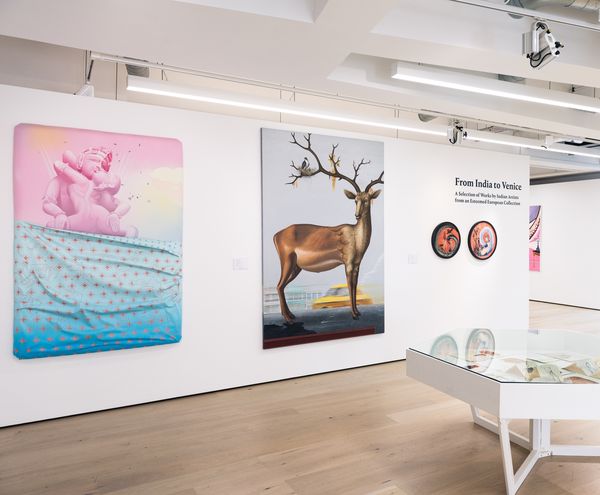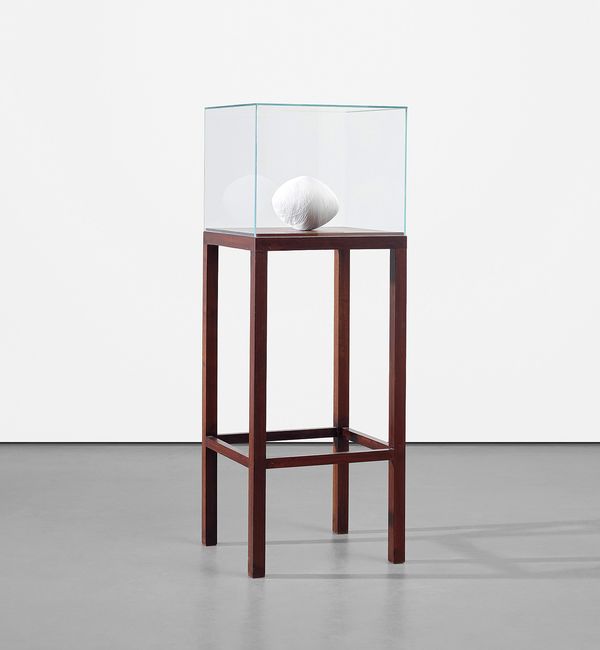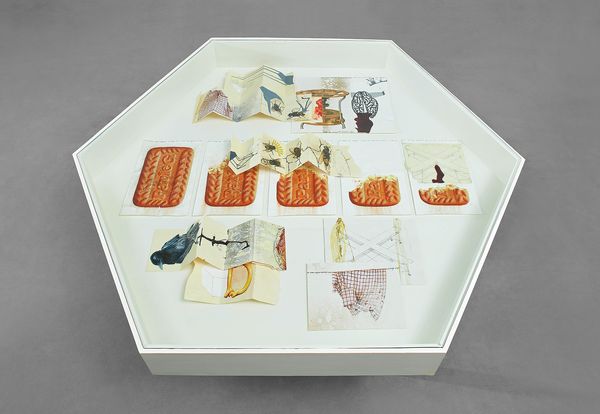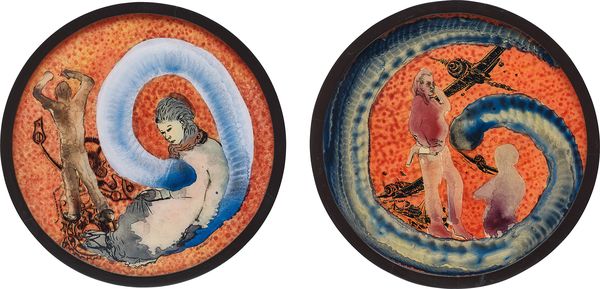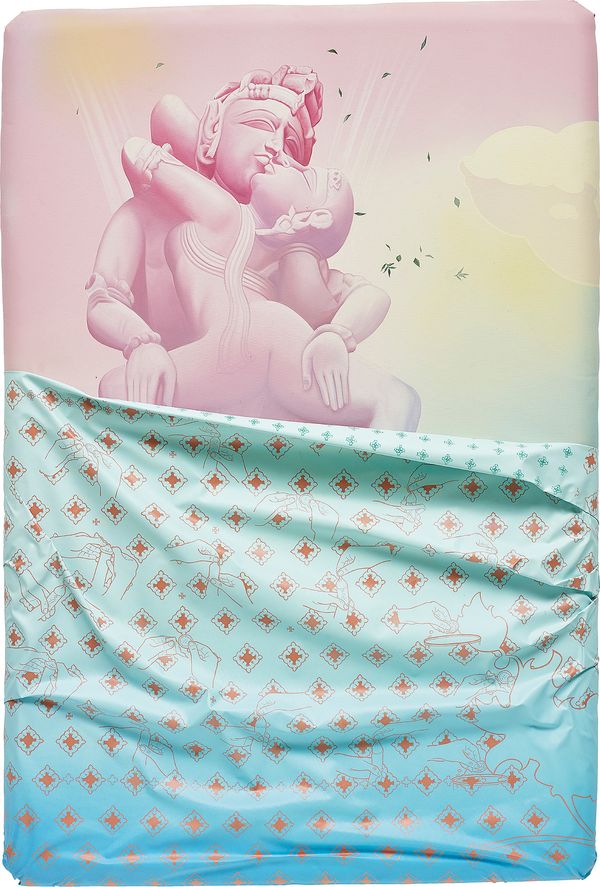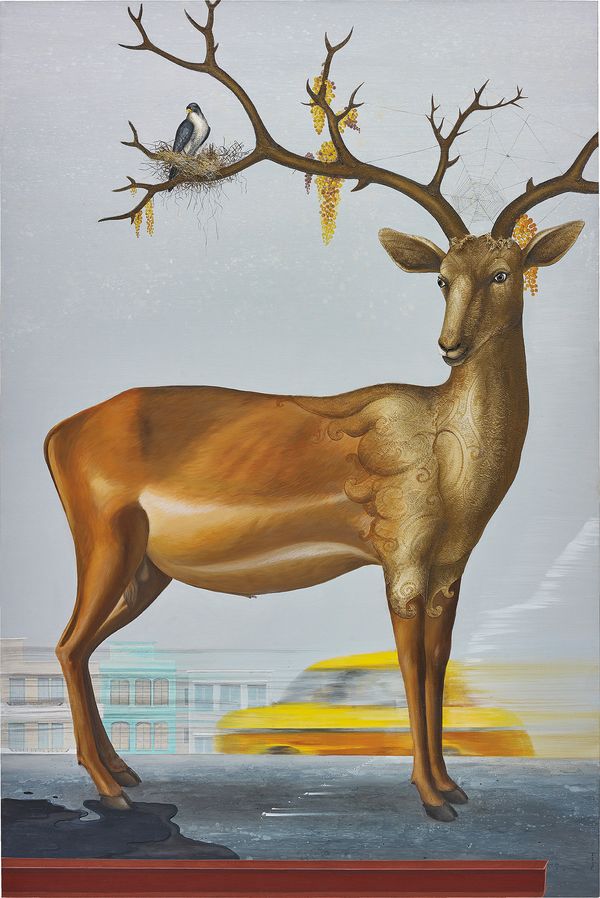The present selection of works on view at Phillips' Berkeley Square galleries
The following selection of works by artists living and working in India are linked by a mutual theme of exploration into the changing environment in which they are created and the influence of both Eastern and Western culture. Housed in an esteemed European collection, this year Atul Dodiya's and Shilpa Gupta's work has been selected to represent India at the country's second ever appearance on the Western stage of the Venice Biennale.
Shilpa Gupta 01:14.9, 2011-2012
Working across multiple mediums Shilpa Gupta’s oeuvre addresses a wide variety of subjects such as the psyche, society and politics, verbalizing their stifled contents. Her work has been featured at major international institutions, including Tate Modern, London, Louisiana Museum, Humlebaek, Centre Pompidou, Paris, and Solomon R. Guggenheim Museum, New York, and the artist has represented India as part of the 56th and current 58th Venice Biennale. 01: 14.9 powerfully illustrates the fraught West, Northwest border between India and Pakistan: 1188.5 miles, as updated on 31 December 2007 depicted with a ratio of 1 to 14.9. Gupta winds 80 miles of thread into an ivory delicate oval egg shape, highlighting the fragility of fear, threat, paranoia and religious prejudices. An edition of this work is owned by the Solomon R. Guggenheim Museum, New York, and a further edition belongs to the Menil Collection, Houston.
Jitish Kallat Afterword (versions of a disappearing act), 2010-2011
Living and working in Mumbai, Jitish Kallat’s works divulge his constant engagement with the concept of time, space, death, cycles of life, our place in the universe and historical nostalgia, moving interchangeably between contemplation of the self and understanding transitory existence within the framework of the eternal. Ageing, distressing and tearing surfaces and elements of his works alludes to these constant musings on time which simultaneously remark upon the unique idiosyncrasies of his home. Dilapidation, degradation, the demolition and reclamation of culture and history are incorporated within Kallat's themes through the artist's perceptive treatment of both subject matter and technique.
Atul Dodiya Krishna Swallowing Forest Fire, 2009-2010
Krishna Swallowing Forest Fire depicts the story of the god Krishna extinguishing a forest fire by swallowing the flames. Intensely cognisant of history, Dodiya entwines stylistic and iconographic characteristics from the East and West, unifying classical myth and political history to fuse fragments of Western art historical masterpieces in a new interpretation. 'In Indian miniature paintings there are many beautiful images of adventures of Lord Krishna as a saviour from the series 'Bhagwat Puran'. Here in my painting Krishna is swallowing forest fire. At the edge of each flame I have placed the museum magnets of great works of art, which I have been collecting from the various western museums. I often convey my interest in the history of art, juxtaposing the references from the diverse sources and try to give a new meaning to an existing image in my work. In this work, it could be me devouring great masterpieces, so in that sense it's also a self-portrait. I enjoy the amalgamation of diverse time and situation in a single picture plane and often feel that the past no longer remains past and reveals itself in the present. The present easily moves and goes back in time. I am fascinated by the idea of mingling time, life and art and it appears empathetically in my work.' - Atul Dodiya (May 2019).
Nalini Malani Two works: (i) Time; (ii) Warriors & Green Worm, 2009
Alluding to a multitude of cultural references from both East and West throughout her oeuvre, and clearly evident in Time and Warriors & Green Worm, Nalini Malani refers to both Greek and Indian ancient mythology amalgamated with contemporary symbols and imagery. This exploration culminates in works that strongly condemn contemporary violence and injustice. Malani’s work is currently on view in the Sharjah Biennial, United Arab Emirates, and it was the subject of a retrospective at the Castello di Rivoli in Turin, Italy, earlier this year. She has been announced as the winner of the Joan Miró Prize 2019 with a solo show set to open at the Fundació Joan Miró in Barcelona in 2020.
Thukral & Tagra Kingdom Come I (Couple), 2011
Jiten Thukral and Sumir Tagra work collaboratively, utilizing a wide range of mediums to increase the possibility and realms of art, breaking from arbitrated and punitive rules to create sensory and immersive works that involve the viewer. Creating a canvas that protrudes and subsequently includes the viewer through invading the mutual space, Kingdom Come I (Couple) invites intrigue and further investigation. Their work is a dynamic dialogue on shifting moral codes in India's modernizing cities. Thukral and Tagra utilise bright, colorful palettes and the glossy luster of pop aesthetics to critically scrutinize taboo subjects like sexuality in this socially-aware vibrant work.
Jagannath Panda The Migrant, 2009
Jagannath Panda's works are often inspired by his native historic state Orissa, famed for its temples and tribal culture, and his current home, chaotically urban and constantly developing New Delhi, bringing together many binary opposites in his work. Sensitive to the issues raised by urbanization and politics, Panda contrasts nature and culture, rural and urban, tradition and modernization to reflect his own experiences and concerns. Migrant uses his motif of animal life to represent these conflictions and concerns around displacement and alienation. Jagannath Panda has received significant international exposure and recognition, having participated in a multitude of international exhibitions including the Mori Art Museum, Tokyo, in 2008.
Yudi Noor Breaking the Water Picture, 2010
Born in West Java, Indonesia, and now living and working in Berlin, Yudi Noor examines the relational state of material as an abstract visual, proffering spiritual denotation through paired back arrangements and compositions in a multitude of mediums.
